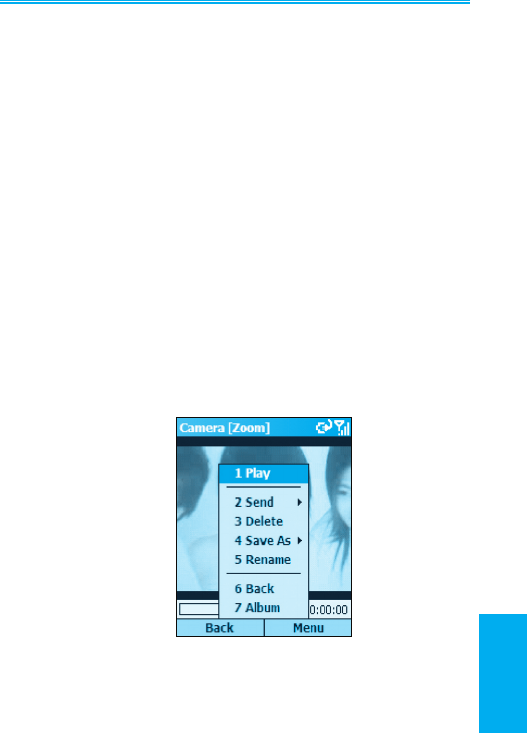HTC TP GSM/GPRS 1900 MHz Bluetooth Smartphone User Manual Typhoon Manual Book indb
HTC Corporation GSM/GPRS 1900 MHz Bluetooth Smartphone Typhoon Manual Book indb
HTC >
Contents
- 1. User Manual
- 2. Users Manual Part 1
- 3. Users Manual Part 2
- 4. Users Manual Part 3
- 5. Users Manual Part 4
Users Manual Part 2

Smartphone User Manual
2. Using
your phone
Smartphone User Manual
2. Using
your phone
40
41
Assigning a Photo ID to a Contact
The Assign Photo command lets you assign an image le
or animated GIF le (“Photo ID”) to an individual Contact
entry stored in your Pocket Contacts, or Phonebook entry
on the SIM card. You can also specify a size, and a position
for the Photo ID.
And, to add more fun and a stronger visual impact to your
incoming calls, you can assign an animated “template ID,”
which will serve as a frame around the image, if desired.
Templates are animated GIF les, and are available in both
Portrait and Landscape orientation. You can choose to
display the Photo ID only, or the Photo ID together with a
template ID, and easily change Photo IDs and/or Template
IDs at any time. A collection of templates are included in
the \\Storage\My Documents\IA Caller ID Photos folder
of your phone.
NOTE: The steps in this section are for the Assign Photo
command on the main menu (individual Contact assign-
ment), but this same basic procedure can also be followed
when:
• Assigning a Photo ID to a Group (using the Assign Photo
command on the menu in the Manage Group screen)
• Assigning “Unknown Photo,” “Not-found Photo,” and
“Default Photo” (using the Assign Photo command on
the menu in the Set Default Photos screen)
• Assigning an individual Photo ID using the Assign Photo
command on the menu accessed when in Detailed View
First, make sure the photo you want to use is either a JPEG,
BMP, or GIF le (either still or animated GIF). By default, the
\\Storage\My Documents folder is searched for these le
types. If the le you want to use is located somewhere else,
you can optionally search other folders in Step 2 below.

Smartphone User Manual
2. Using
your phone
Smartphone User Manual
2. Using
your phone
42
43
1. In the main Caller ID screen, select the desired Contact
in the list.
2. Select Assign Photo from the menu, or simply press the
Left Softkey. The rst Assign Photo screen will appear.
In it, your JPEG, BMP, and GIF les will be displayed as
thumbnails.
Optional: Or, you can use your phone’s camera to take a
new picture and then assign it as a Photo ID. Open the menu
in this Assign Photo screen and select New from Camera.
This switches to Camera so you can take a new photo. After
taking a new photo, you will be returned to Caller ID so you
can assign the new photo as a Photo ID.
3. Select the le you want to use as the Photo ID.
4. Press the Left Softkey (“Next”). A Preview screen
opens.

Smartphone User Manual
2. Using
your phone
Smartphone User Manual
2. Using
your phone
42
43
If Use Template is active in the Display Settings screen, the
photo is previewed in a template when you press “Next.” An
example is shown below in the gure on the right. You can
use the menu in this Preview screen to preview the Next
Template or Previous Template, or press the Right or Left
navigational buttons.
If Use Photo Only happens to be active in the Display Set-
tings screen, the photo alone is previewed with a pre-set
sample name and phone number, according to the current
Position setting in Display Settings. An example is shown
on the left below.
5. If this Preview screen already shows the setup you want,
press the Left Softkey (“Done”).
Or, to access various setup options, press the Right
Softkey to open the menu.

Smartphone User Manual
2. Using
your phone
Smartphone User Manual
2. Using
your phone
44
45
Select Display Settings from the menu if you want to switch
to either Photo Only assignment or Use Template assign-
ment. If you choose Photo Only, you can specify one of
several positions, and a size. If you choose Use Template,
you can specify the template to be used, and the method for
tting the photo on the Incoming Call screen.
You can also open the Display Settings screen outside of
the “Assign Photo” process by selecting Options > Dis-
play Settings from the main menu in List View, and you
can preview the behavior of any Photo ID assignment by
selecting Preview.
2.4 In-call options
Listed below are all the menu options that might possibly be
available when a call is in progress. Some of these options
are only available when multiple calls are in progress or
during a conference call.
End — Disconnect the call.
Hold — Place the active call on hold.
Unhold — Activate the call on hold.
Swap — Switch between two calls.
Save Contacts — Create a Contact record for the caller.
Conference — Join together all existing calls, if you have
subscribed to this service.
Private — Break one call out of a conference and makes this
call active while the rest of the conference is on hold.
Speakerphone — Increase the volume of the earphone.
Mute — Mute the microphone for the active call. The other
party will not hear anything you say, but you can still hear
the other party.
Unmute — Turn the microphone back on for the active
call.

Smartphone User Manual
2. Using
your phone
Smartphone User Manual
2. Using
your phone
44
45
2.5
Retrieving a voice mail message
On the Home screen, press and hold 1 (varies with operator)
to call your voice mailbox, and follow the prompts to retrieve
your messages.
NOTE: This is actually a Speed Dial (see section 2.7).
Speed Dial 1 is reserved for voice mail access and the
number is congured in your settings.
2.6 Reviewing your calls
Using Call History and Call Timers, you can view infor-
mation about phone calls that you have made and received.
For example, you can see who has called you recently and
nd out how much time you have spent talking on the
phone.
Call History
Call History displays the last 36 calls that you have made,
received, and missed. Each entry in Call History contains
the start time of the call, the duration, the caller's name,
if available, and the caller's number. The oldest calls are
automatically deleted from the list to make room for the
newest calls.
To view your Call History, select Call History from the
Start menu. If desired, you can then lter the list so that
only Missed Calls, Incoming Calls, or Outgoing Calls are
listed. Simply open the menu in the Call History screen,
select Filter, and then select the desired category from the
submenu.

Smartphone User Manual
2. Using
your phone
Smartphone User Manual
2. Using
your phone
46
47
Other commands on the menu in the Call History screen
besides Filter:
Find Contact — Lets you view Contact information related
to the selected entry.
E-mail — Select the entry in the Call History list to whom
you want to send E-mail, then select E-mail on the menu.
You will be switched to the Messaging screen.
View Timers — Opens the Call Timers screen. See the
subsection below for details.
Delete — Remove the selected item from the list.
Delete List — Remove all items in Call History.
Save to Contacts — Create a new Contact entry using the
info related to the selected item in Call History.
Call Timers
Call Timers gives you detailed information regarding the
length of your last call, the total number of calls made and
received, calls by type (incoming, outgoing, roaming, and
data), and a lifetime counter.
Call Timers is useful for keeping track of your calling patterns,
for example to determine what type of calling plan you want.
It can also help you estimate your monthly billing. You can
reset Call Timers to zero (0), for example to start timing calls
for a new monthly billing cycle.
To access the Call Timers screen, select Call History from
the Start menu, then open the menu in the Call History screen
and select View Timers.

Smartphone User Manual
2. Using
your phone
Smartphone User Manual
2. Using
your phone
46
47
2.7 Speed Dials and Voice Tags
You can create “Speed Dials” for frequently-called phone
numbers by simply pressing and holding one or two keys.
You may choose Speed Dial entries from 2-99; Speed Dial
1 is reserved for voice mail access and the number is con-
gured in your settings.
You can create a Speed Dial for a phone number, a program
on the Start menu, an E-mail address, or Web page address
(URL) that is stored in Contacts.
Speed Dials
Creating a Speed Dial for a phone number:
1. In the Home screen, press the Right Softkey (“Contacts”),
or select Contacts from the Start menu.
2. Select the desired Contact entry and then press the Action
button to access the Contact card. All data entered for
that Contact will be listed.
3. Select the phone number for which you want to assign a
Speed Dial.
4. Press the Right Softkey to open the menu and select Add
Speed Dial.
5. In the Keypad Assignment eld of the Add Speed Dial
screen, select the number you want to assign as the Speed
Dial. Press the Left or Right navigational button to select,
or press the Action button to view the full list of choices.
6. Press the Left Softkey (“Done”) to save the new Speed
Dial.

Smartphone User Manual
2. Using
your phone
Smartphone User Manual
2. Using
your phone
48
49
For URLs and E-mail addresses:
You can also create Speed Dials for URLs (Web addresses)
and E-mail addresses that are stored in Contacts. In Step 3
above, just select the desired E-Mail address or URL address
(instead of a phone number).
Making a call using a Speed Dial:
When in the Home screen, press and hold the number on the
keypad that you have assigned as a Speed Dial for a number.
If the Speed Dial number consists of two digits, press the rst
digit and then press and hold the second digit.
Viewing Speed Dials you have created:
In the Home screen, select Speed Dial from the Start menu.
All Speed Dial entries will be listed. In addition, you can use
the menu in this screen to perform the following:
Run — Invoke the contact method associated with the
selected Speed Dial (dials a number, starts Internet Explorer,
or invokes Messaging). You can perform this same function
by pressing the Left Softkey (“Go”).
Find Contact — Open the Contact card associated with the
selected Speed Dial.
Delete — Delete the selected Speed Dial entry from the
list.
Filter — Lets you lter the list.

Smartphone User Manual
2. Using
your phone
Smartphone User Manual
2. Using
your phone
48
49
Voice Tags
You can record a voice tag for a phone number, E-mail ad-
dress, or Web page address that is stored in your Contacts.
Then, when you speak the voice tag, your phone automati-
cally dials the associated phone number, opens an E-mail
message using the associated address, or goes to the as-
sociated Web page.
Creating a Voice Tag for a phone number, E-mail ad-
dress, or URL in your Contacts:
1. In the Home screen, press the Right Softkey (“Contacts”),
or select Contacts from the Start menu.
2. Select the desired Contact entry and then press the Action
button to access the Contact card. All data entered for
that Contact will be listed.
3. Select the phone number, E-mail address, or Web page
address for which you want to assign a Voice Tag.
4. Press the Right Softkey to open the menu and select Add
Voice Tag.
5. After the message/beep, begin recording the voice tag
(preferably one easy-to-recognize word).
6. After the second beep sound, the phone will play back the
voice tag. Select “Add Speed Dial.” The phone will play
back the voice tag.
7. Press the Left Softkey (“Done”) to save the new voice
tag.
To use the voice tag, press and hold the Volume Down button
on the left side of the phone for three seconds in the Home
screen, to invoke the recording function. Say the word that
you recorded as a voice tag. The phone plays back the voice
tag and then dials the associated phone number; or opens a
new E-mail message; or goes to the associated Web page
(whichever you chose prior to creating it in Step 3 above).

Smartphone User Manual
2. Using
your phone
Smartphone User Manual
2. Using
your phone
50
51
Creating a Voice Tag for an application
You can also associate a voice tag with an application. For
example, to build a voice tag for the Calendar application,
do as follows:
1. In the Home screen, press the Left Softkey (“Start”), to
open the Start menu.
2. In the Start menu, highlight the “Calendar” item in the
menu.
3. Press the Right Softkey to open the menu and select Add
Voice Tag.
4. After the message/beep, say “Calendar.”
5. After the second beep sound, say “Calendar” again. The
system will play back the voice tag.
6. Press the Left Softkey (“Done”) to save the new voice
tag.
In the future, you can invoke the Calendar application by
holding the recording button in the Home screen and then
saying “Calendar” after the beep. The system will repeat the
voice tag “Calendar” to indicate that it recognized the word,
and then will launch Calendar. If the phone misinterprets
the word, press the End softkey and start over.
Editing, Deleting, and Playing Voice Tags
Select Speed Dial from the Start menu. Select the desired
voice tag from the list. Then:
• To change it, select Edit, then make changes and select
Done.
• To delete it, select Delete from the menu.
• To play back an existing voice tag at any time, select Play
Voice Tag from the menu.

Smartphone User Manual
2. Using
your phone
Smartphone User Manual
2. Using
your phone
50
51
Creating and managing Voice Notes
This feature provides a convenient way for you to create
a verbal reminder (in lieu of entering text) by using your
phone’s built-in audio recorder.
When in the Home screen, select Voice Notes from the
Start menu, or hold down the Volume Up button for three
seconds (on the left side of the phone). The All Notes screen
will open, and will list all Voice Notes you have previously
recorded, if any.
To start recording a new Voice Note, press the Left Softkey
(“Record”), or select Record from the menu. The record-
ing process begins immediately. A time counter will display
on the screen to let you know how much time has elapsed
during the current recording.
Speak closely into your phone’s microphone, then press the
Left Softkey (“Stop”) to stop recording. You will be returned
to the All Notes screen. The new voice le will automatically
be saved using a default lenaming convention of “Record-
ing1,” “Recording2,” etc.
To Play, Rename, or Delete an existing recording, select
the desired voice le in the list, then open the menu (Right
Softkey) and select the appropriate command.

Smartphone User Manual
2. Using
your phone
Smartphone User Manual
2. Using
your phone
52
53
2.8 Advanced dialing information
The following information covers advanced dialing options
that may be useful for phone numbers requiring special
dialing instructions.
Inserting an international country code
International calls require a country code to be included in the
phone number. A plus sign (+) must appear rst, followed by
the country code and the rest of the phone number. To enter
the plus sign, press and hold 0 until + appears.
Inserting a three-second pause in a
dialing sequence
Some international calls require a three-second pause in the
dialing sequence in order for the call to process successfully.
To insert a pause:
1. In the Home screen, select Contacts from the Start menu,
or press the Right Softkey (“Contacts”).
2. Select the Contact entry in whose phone number you want
to insert a pause, then press the Action button to access
the Contact card for that entry.
3. Press the Left Softkey (“Edit”), or select Edit from the
menu.
4. In the Edit screen, select the specic phone number in
which you want to insert the pause. Then press the Left or
Right navigational buttons to position the cursor within the
number where you want to insert a three-second pause.
5. Open the menu and select Insert Pause. The letter "p" will
appear in the number for your reference, to show where the
three-second pause will occur in the dialing sequence.
6. Press the Left Softkey (“Done”).

Smartphone User Manual
2. Using
your phone
Smartphone User Manual
2. Using
your phone
52
53
Inserting a manual pause in a dialing
sequence
There may be phone numbers that require a pause longer
than three seconds in the dialing sequence. For these cases,
you can pause as long as you want, and manually continue
the dialing sequence using the Talk button.
Follow the same steps outlined above in “Inserting a three-
second pause in a dialing sequence,” except in Step 5, select
Insert Wait from the menu. The letter “w” will appear in
the number for your reference, to show where the indenite
pause will occur in the dialing sequence. Don’t forget that
when you call a number containing a “manual pause,” you
will need to press the Talk button to continue dialing.

Smartphone User Manual
2. Using
your phone
54

Chapter 3
Using Your Camera
3.1 Camera mode
3.2 Album mode

Smartphone User Manual
3.
Using your
camera
Smartphone User Manual
3.
Using your
camera
56
57
3.1 Camera mode
When in Photo capture mode, you can capture standard still
images. In Picture Theme capture mode, you can place
your captured images into attractive frames (templates). Use
Photo ID capture mode to capture an image that you want to
assign to one of your Contacts as a Photo ID. Or, switch to
Video or MMS Video capture mode and capture “live” video
streams (with audio if desired), then share them with others.
You can even send the captured les via E-mail or MMS.
Invoking Camera mode
Use any of these methods to switch to Camera mode on
your phone:
• Press the hardware button on the right side of the
device.
• Select Camera or Camcorder from the Start Menu,
or select Album and then press the Left Softkey
(Camera).
• If already invoked recently, you can select the appropriate
icon in the “recently used programs” bar at the top of the
Home screen:
Choosing a Capture submode
When in Camera mode, select Capture Mode from the main
menu, and then select either Photo, Video, MMS Video,
Photo ID, or Picture Theme from the submenu.

Smartphone User Manual
3.
Using your
camera
Smartphone User Manual
3.
Using your
camera
56
57
Capturing a still image
Select Camera from the Start Menu to go directly to Photo
capture mode. If already in a different capture mode, open
the menu and select Photo from the Capture Mode sub-
menu, or press 1 on the keypad to switch to different capture
submodes.
The current capture size (Resolution) dimensions are shown
near the top of the screen. Press 2 on your keypad to select
the Resolution (640 x 480, 320 x 240, or 160 x 120). Press
the Up button if you want to Zoom In, or the Down button to
Zoom back out. Near the bottom of the screen, the current
Zoom ratio is shown. (The size of the Preview window,
shown in the example below, is xed at 176 x 144 pixels.)
Besides specifying a capture size, you can also specify the
destination storage media for saved les, rename them after
capturing them, and an output quality (the output format for
image capture is JPEG). The number of images you can
still capture, according to available memory and your current
settings, is always displayed.
To capture the image, press the hardware Camera button on
the right side of the phone, or the Left Softkey (“Capture”),
or the Action button.

Smartphone User Manual
3.
Using your
camera
Smartphone User Manual
3.
Using your
camera
58
59
Capturing a video using Video mode
Select Camcorder from the Start Menu to go directly to
Video capture mode. If already in a different capture mode,
open the menu and select Video from the Capture Mode
submenu, or press 1 on your phone keypad to switch to
different modes.
The Capture Size dimensions are shown near the top of the
screen. Press 2 on your keypad to select the size (176 x
144, or 128 x 96). Press the Up button if you want to Zoom
In, or the Down button to Zoom back out.
To specify the output format, select Options from the menu
and then Modes. In the Encoder eld, select either MPEG4,
H.263, or Motion-JPEG AVI. Also in this screen, you can
set a limit to the video le size, if desired.
Select Options > Video to specify whether or not to capture
audio to accompany the video clip, and to change the default
lenaming convention if desired. As a shortcut, you can
press the 6 button on your phone keypad to toggle audio-
capture capability On and Off. An icon resembling a micro-
phone in the lower left of the Video Capture screen indicates
whether audio capture is enabled or disabled. When Off, a
diagonal line is drawn through the icon.
The amount of time available for your next video capture,
according to available memory and your current settings, is
always displayed.
To begin capturing a video clip, press the hardware Camera
button on the right side of the phone, or the Left Softkey
(“Capture”), or the Action button. Press any of them again to
stop recording. If a limit has been set for the video le size,
recording will stop automatically when the limit is reached.

Smartphone User Manual
3.
Using your
camera
Smartphone User Manual
3.
Using your
camera
58
59
Capturing a video using MMS Video
mode
The usage and options for MMS Video capture mode are the
same as for Video capture mode, except for the following:
Whereas the Video capture mode allows you to set any le
size limitation, MMS Video mode is permanently set to a
le size limitation of 95 KB. When the video currently being
recorded reaches a le size of 95 KB, the recording process
will automatically be stopped.
In addition, when in MMS Video mode, there are only two
choices for Encoder type: MPEG-4, and H.263. Typically,
it is recommended that you use H.263 for video les to be
sent as MMS attachments.
Using Photo ID mode
The Photo ID capture mode captures a still image in the
same way as Photo capture mode, but captures at a size
(176 x 180) which is convenient to use directly as a Photo
ID for one of your contacts. Immediately after capturing an
image using Photo ID capture mode, you can select Save
As > Caller ID Photo from the menu in the Review screen
(shown later in the section entitled The Review screen) to
invoke the Caller ID (Photo Contacts) application.
In Caller ID, all entries in your Pocket Contacts will be listed.
Select the Contact to which you want to assign the image
you just captured. Then press the Left Softkey (“Next”) and
then again (“Done”) to assign the photo. After that, you
will be returned to the Capture screen of Capture mode
automatically.

Smartphone User Manual
3.
Using your
camera
Smartphone User Manual
3.
Using your
camera
60
61
Using Picture Theme mode to frame your
captured photos
The Picture Theme capture mode lets you place your cap-
tured images into selected frames.
When in Camera mode, select Capture Mode > Picture
Theme from the menu, or press 1 on your keypad until
Picture Theme is the active capture mode.
When you switch to Picture Theme, one of your templates
in the \My Documents\Frames folder will be loaded. To
load a different template, press the Left or Right navigational
buttons; or select Select Template from the menu to browse
and preview each template. The lename, dimensions, and
number of images required for that template will be displayed
in the Select Template screen, as shown below on the left.
The gure on the right below shows the Picture Theme
capture mode, ready to capture an image. The incoming
video stream is previewed in the “place holder” where the
captured image will be placed. (In templates that require
two or more images, the focus switches to another “place
holder” after the rst one is lled.)

Smartphone User Manual
3.
Using your
camera
Smartphone User Manual
3.
Using your
camera
60
61
To capture an image, press the hardware Camera button on
the right side of the phone, the Left Softkey (“Capture”), or the
Action button. The image will be saved with the frame.
Zoom capability is determined by the currently loaded tem-
plate, as shown later in the table in the “Zooming in and
out” section.
The Review screen
If the Review after capture checkbox is checked in the Op-
tions > General screen (it is checked by default), a Review
screen will appear immediately after you have captured a
le using any of the ve capture submodes.
In the example below, a video le has just been captured,
so the rst frame of the video le is shown in the Review
screen.

Smartphone User Manual
3.
Using your
camera
Smartphone User Manual
3.
Using your
camera
62
63
The menu in the Review screen lets you:
• Play the video. A Progress Bar at the bottom of the screen
will indicate progress of the playback. (Note that the Play
command is available on this menu only if the captured
le is a video le.)
• Send it immediately (via E-mail, or via MMS if you have
it).
• Delete it if you decide you don’t want to keep it.
• Switch to the Caller ID application (if you have it) and Save
As a Photo ID for a Contact entry, as explained earlier.
• Keep and Rename it.
• Keep it with its automatically assigned lename, and go
Back to the Capture screen, ready to do more captures.
• Switch to the Thumbnail View of Album mode.
In the previous gure (Review Mode screen), the Title Bar
indicates Zoom mode. You can press the Up and Down
buttons to Zoom In and Out.
Or, press the Action button to switch to Pan mode. If the
image is too large to t in the display area, you can press
the Up, Down, Left, or Right buttons to pan the image to the
desired position.

Smartphone User Manual
3.
Using your
camera
Smartphone User Manual
3.
Using your
camera
62
63
Zooming in and out
When in one of the ve capture modes, you can press the
Up/Down button to Zoom In/Out. However, Zoom capability
depends on the current Capture Mode, Encoder type, and
Resolution (Capture Size), all of which can be specied in
the Options > Mode screen.
Another way to zoom is to select Zoom on the menu.
Capture mode Capture Size setting Zoom available
Photo 160 x 120 1x, 2x, 4x
320 x 240 1x, 2x
640 x 480 None
Photo ID 176 x 180 1x, 2x
Picture Theme Depends on the size of the currently loaded tem-
plate. Examples:
160 x 120 template 1x, 2x, 4x
320 x 240 template 1x, 2x
640 x 480 template None
800 x 480 template None
Video and
MMS Video
128 x 96 1x, 2x
176 x 144 1x, 2x
NOTE: “1x” indicates normal (unzoomed) size.

Smartphone User Manual
3.
Using your
camera
Smartphone User Manual
3.
Using your
camera
64
65
Adjusting for various lighting conditions
From the main menu, select Ambience. The Ambience
submenu lets you easily adjust the Capture screen so that
it looks its best in various environments. Auto is the default
setting, which means it will automatically adjust to different
lighting conditions. You can optionally select Daylight,
Incandescent, Fluorescent, or Night.
Or, you can affect the color display of the incoming video
stream by selecting Grayscale (black and white), Sepia
(light orange hue) or Cool (blue tint).
Adjusting Camera Properties
In addition, you can select Adjust View from the Ambi-
ence submenu if you wish to make adjustments to various
Camera Properties of the sensor output. After the Adjust
View screen opens, you can press the Up or Down button to
change the Property (either Gamma, Brightness, Satura-
tion, or Hue), then press the Right or Left button to change
the value of the current Camera Property. If you wish to re-
set the Camera Properties to their original default settings,
simply open the menu in the Adjust View screen and select
Restore Default.
Setting various Options
After you select Options from the menu, you can enter dif-
ferent screens to customize various behaviors of Camera
mode, as follows:
General
In the General screen, you can:
• Specify the storage media to which newly-captured les
are saved: Mini SD card, or Internal Memory (\Storage\My
Documents).

Smartphone User Manual
3.
Using your
camera
Smartphone User Manual
3.
Using your
camera
64
65
• Set the Flicker Adjustment according to the electrical
voltage used in your country.
• Enable Review mode, so that every time you capture any
new image or video le, you will enter the Review screen
(shown and explained earlier). It is enabled by default.
• Disable the audible “shutter” sound so that images will be
captured silently.
Counter
By default, sequential numbers are incorporated into the le-
name of each new image or video you capture. This screen
lets you re-set the counters individually to 001.
Photo
All still images you capture are saved in the JPEG format.
In the Photo screen, you can specify a JPEG quality (Basic,
Normal, Fine, Superne), and you can change the default
lename prex if desired.
The location you specify in the Template Folder eld is
where Camera will look for templates when you enter Picture
Theme mode. You can choose Storage Card or Internal
Memory. If Internal Memory is chosen, Camera will look in
the \Storage\My Documents\Frames folder of your phone,
where a collection of template les is located. Likewise,
if Storage Card is chosen, it will look in \My Documents\
Frames of the Storage Card.
Video
By default, all video clips you capture will have accompanying
audio recorded along with the video. In this screen, you can
disable or re-enable the recording of audio along with your
video les. (Or, when in a Capture screen, you can simply
press 6 on your phone keypad to toggle audio capture On
and Off.) You can also change the default lename prex
which is used for each new video capture.

Smartphone User Manual
3.
Using your
camera
Smartphone User Manual
3.
Using your
camera
66
67
Modes
The elds available in the Modes screen will vary depend-
ing on the Capture Mode and Encoder type selected. (The
“Encoder” is the output format of newly-captured les.)
If Photo is the selected Capture Mode, you can choose the
desired Resolution (capture size). They are all listed in the
table in the “Zooming In and Out” section.
If Video is the selected Capture Mode, you can use the
Encoder eld to specify what le format to record in, and
a desired Resolution. In addition, you can set a maximum
limit to the le size. For example, if you enter 600 KB in the
Limit Video File Size eld, then recording will automatically
stop when that le size is reached.
If MMS Video is the selected Capture Mode, the “Limit Video
File Size” eld is not available. This is because the maximum
le size is set to 95 KB for MMS Video captures. Encoder
types available are MPEG-4 and H.263.
There are no changeable options available in the Modes
screen when Picture Theme or Photo ID is the selected
Capture Mode.
NOTE: Another way to enter the Modes screen is to select
Menu > Capture Modes > Manage.
Switching to Album Mode to view and
manage your images/videos
• Select Album from the menu when in a Capture mode or
in Review mode.
• Press the * key or the # key on your phone when in a
Capture mode.

Smartphone User Manual
3.
Using your
camera
Smartphone User Manual
3.
Using your
camera
66
67
3.2 Album mode
The Album mode of Camera allows you to view the image
and video les you have captured, as well as audio les and
images/videos you have obtained from other sources such
as E-mail, a mini SD card, infrared beaming, or synchronized
from a PC.
You can manipulate and organize the les into “albums”
and slide shows with fancy transition effects. View images
as thumbnails in various sizes, or in an enlarged view. You
can zoom in/out, ip horizontally or vertically, rotate, sort,
associate les, and more. In addition, if you connect to a
server with media content via the Internet, Album can play
the streaming media.
Supported File Formats
Still-image
formats
JPEG (.jpg, .jpeg, .jpe); GIF (.gif, .giff);
Bitmap les (.bmp, .2bp, .wbmp, .wbm)
Animation
format
Animated GIF
Video format Motion-JPEG AVI (.avi)
MPEG-4 Simple prole (.mp4)
3GPP – H.263 baseline (.3gp)
Audio formats MPEG-4 AAC (Advanced Audio Coding) in
.MP4 format
WAV
MIDI (standard MIDI type 0, 1, and SP-MIDI)
Note that some le types, although not supported by Album,
will still be represented as icons in Thumbnail View, such
as WMA, WMV, and MP3. For example, MP3 les will be
represented as Windows Media Player icons in Album, and
selecting the icon will invoke Media Player to play the le.

Smartphone User Manual
3.
Using your
camera
Smartphone User Manual
3.
Using your
camera
68
69
Thumbnail view mode
Camera searches for the supported image, video, and audio
les in your \My Documents folder. You can use the Change
Folder command to search other folders if desired. Select
Scan Subfolder Files in Options > General if you also want
the subfolders of the parent folder to be searched.
Shown below on the left is Large thumbnail size. An ex-
ample of List View is shown on the right. Use the Options >
Thumbnail screen to change to other thumbnail views such
as Normal, Small, or Portrait. You can also opt to show an
index number and an “info bar” which displays data about
the selected thumbnail (shown on the left below).
Large thumbnails with Info Bar List View
To play a video le or audio le, or to view a still image in an
enlarged view, select the related thumbnail and then press
the Action button to switch to Detailed View.

Smartphone User Manual
3.
Using your
camera
Smartphone User Manual
3.
Using your
camera
68
69
Detailed View mode
Detailed View mode utilizes more of the screen to display still
images or to play back video, animated GIF, or audio les.
Press the Left or Right navigational button to display the
previous or next le. Press the Up or Down button to Zoom
In or Out. If too large to t in the display area, press the
Action button to switch to Pan mode. You can then press
Up/Down/Left/Right to pan the desired portion into view.
The gure below shows a video le during playback. The
Title Bar shows us that this le is indexed as #1 and Pan
mode is active.
A progress bar and time counter near the bottom of this
screen indicate that 12 seconds have played thus far, and
the le format is H.263 video with AMR audio track.
If you wish to view les in Full Screen mode, select View >
Full Screen from the menu, or press the 6 button on your
keypad to toggle between Detailed View and Full Screen.
Press 7 to play/pause, or 8 to mute/unmute audio play.
Press * for Actual Size, or # for a Fit-in-window display.

Smartphone User Manual
3.
Using your
camera
Smartphone User Manual
3.
Using your
camera
70
71
Slide Show view mode
First, in Thumbnail View mode, select the thumbnail that you
want to appear initially in the slide show. Then select Slide
Show from the menu. The slide show will then begin with
the currently selected le.
Or, as a shortcut, you can press 0 when in either Thumbnail
View or Detailed View to start a slide show. Each image,
video, and audio le in the current folder will be played us-
ing the full screen, according to the settings that have been
specied in the Slide Show Options screen.
The Slide Show Options screen can be accessed by either
selecting Slide Show Options from the menu during Slide
Show view mode, or by selecting Options > Slide Show
from the menu when in Thumbnail View mode. The options
are summarized in the next section.
During a slide show, pressing 6 will also toggle the display
of the Title Bar and Softkey Labels on and off; or, select Full
Screen from the menu. Even if the Softkey labels are not
displayed, you can still press the Right Softkey to open the
menu, or the Left Softkey to end the slide show. You can also
end a slide show by selecting End Show from the menu, or
by pressing the * button or your phone’s Back button.
To pause a slide show, press the Action button. When
ready to continue playing the slide show, press the Action
button again.
During a slide show, you can press the Left and Right navi-
gational buttons to traverse to the previous or next slide.
To choose the type and speed of transition effects to be used
during a slide show, select Transition Effects from the menu
when in Slide Show view. Or, when in Thumbnail view, you
can select Options > Transition Effects from the menu.

Smartphone User Manual
3.
Using your
camera
Smartphone User Manual
3.
Using your
camera
70
71
Summary of Options screens
Select Options from the menu when in Thumbnail view to
access the following screens:
General
The options in this screen let you choose whether or not
to:
• Search subfolders of the current folder for les of the
supported types.
• Show the images in ROM in the Album screen.
• Force backlight and power to remain on during video and
audio playback.
• Mute audio while playing video les.
• Automatically replay video, audio, and animated GIF
les.
• Show or hide the Progress Bar during playback in Detailed
View.
• Automatically rotate left, right, or never.
Slide Show
In this screen you can specify:
• The amount of time each le will display during the slide
show.
• A rule for slide rotation during slide shows.
• The order of slide play (forward, backward, or random).
• Whether or not to force the backlight and system power
to stay on during a slide show.
• Whether or not you want each slide show to start in Full
Screen view (Title Bar and Softkey labels are hidden).

Smartphone User Manual
3.
Using your
camera
Smartphone User Manual
3.
Using your
camera
72
73
Transition Effects
Select from dozens of transition effects to be used between
slides during a slide show, and specify the speed. This
screen also lets you preview each choice before selecting
it.
Sort By
Lets you sort the sequence of the les in the current folder
according to Name, Date, Size, or Type. Then specify As-
cending or Descending order.
Thumbnail
Choose the size for the thumbnails displayed in Thumbnail
mode: Small, Normal, Large, Portrait, or List view. In addi-
tion, you can optionally show an index number in the upper
left corner of each thumbnail; and an “Info Bar” in which data
about the selected le is displayed.
Association
Choose the letypes you want to associate with Album.
Then, whenever you select a le of that type, it will auto-
matically be opened in Album (Bitmap, JPEG, GIF, AVI,
MPEG4, MIDI, and WAV).
Network
The values in the two UDP Port Range elds refer to the
range of protocol used to transfer data through the Internet.
These should already be assigned to the optimal values by
your operator, and normally will not need to be changed.
Specify the network to be used in the Connect Via eld.

Smartphone User Manual
3.
Using your
camera
Smartphone User Manual
3.
Using your
camera
72
73
Summary of Menu Functions
Some of the functions that the menus in Thumbnail View
and Detailed View allow you to perform:
• Send the selected le via MMS or E-mail.
• Delete the selected le.
• Save As a Caller ID Photo.
• Save As RingTone Line 1 or Line 2 (if a MIDI le is
selected).
• Rename the selected le.
• View Properties of the selected le (such as name, folder,
date, size, type, colors, frames, dimensions, resolution,
audio type, channel, etc.).
• View the current le in Full Screen (Title Bar and Softkey
labels are hidden).
• Rotate an image 90 degrees clockwise.
• Change to another folder and display les of the supported
letypes in that folder, including sub-options to switch to
\My Documents on your SD card, jump up one level, or
select recently visited folders.
• The New command in Thumbnail view includes a sub-
option to invoke the voice recorder function of your phone
and record a Voice Note.
• Switch to Camera mode.

Smartphone User Manual
3.
Using your
camera
74

Chapter 4
Personalizing your
phone
4.1 Customizing phone settings

Smartphone User Manual
4.
Personalizing
Smartphone User Manual
4.
Personalizing
76
77
4.1 Customizing phone settings
You can easily view and change various settings in your
phone. For example, you can use your own sounds for
ring tones, use your favorite photo for the Home screen
background, set up Call Forwarding to manage your calls
more efciently, and more.
In the Home screen, select Settings from the Start menu.
The items in the Settings screen are illustrated below.
Phone
When you select Phone in the Settings screen shown
above, the Phone screen appears and offers the following
options:
Call Barring
Enables you to block incoming and/or outgoing calls.
Call Forwarding
Enables you to forward calls to another number.

Smartphone User Manual
4.
Personalizing
Smartphone User Manual
4.
Personalizing
76
77
Call Options
Specify your Voice Mail number, SMS Service Center number,
Country code, and Area code. If you check the Any key an-
swer checkbox, you will be able to answer incoming calls by
pressing any key. If Show SIM Contacts is checked, entries
on the SIM card will be displayed in your Contacts list.
Call Waiting
Turn the Call Waiting function on or off.
Caller ID
Let your identication be known to all callers; to only the people
in your contacts; or to no callers.
Channels
Congure cell broadcast.
Fixed Dialing
Limit your calling area to one or more specic phone numbers
and/or area codes.
Networks
Identies your current network, and allows you to change your
network selection from Automatic to Manual. In addition, the
menu in the Networks screen lets you nd a new network,
select a network, and list preferred networks.

Smartphone User Manual
4.
Personalizing
Smartphone User Manual
4.
Personalizing
78
79
Sounds
Sounds settings are used to customize the sounds for ring
tones, notications, and reminders.
Select Settings from the Start menu, then select Sounds
in the Settings screen. The Sounds screen will open, in
which you can specify what sound le to use for the follow-
ing functions:
• Ring tone
• Reminders
• New E-mail arrival
• New text message arrival
• New voice message arrival
• New instant message arrival
• New channel message arrival
• Alarm clock
• SIM toolkit messages
• Exclamation
• Question
• Warnings
• Keypad control
After selecting one of the elds above, you can press the
Right or Left navigational buttons to select different sounds.
Or, press the Action button to open the Select an Item screen
to view the entire list of sounds available for that eld, and
select from that screen.
You can use the menu in the Sounds screen to Play or
Delete the selected item.
Press the Left Softkey ("Done") to save all changes.

Smartphone User Manual
4.
Personalizing
Smartphone User Manual
4.
Personalizing
78
79
To use your own sound:
1. Go to where your sound le is stored on your desktop
computer and copy the le.
2. In ActiveSync on your desktop computer, click Explore,
go to \Storage\Application Data\Sounds, then paste the
sound le into the Sounds folder.
3. In the Home screen on your phone, select Settings >
Sounds from the Start menu.
4. Select the desired category (such as Ringtone, Reminders,
New E-mail, etc.), specify a sound, then press the Left
Softkey ("Done").
Proles
Prole settings are used to congure how your phone noti-
es you of events such as an incoming call, an approaching
appointment, or an arriving message. For example, when
you are attending a meeting, you can choose the Meeting
prole, which lowers the ring of your phone and noties you
of incoming calls via vibration. Each prole is pre-dened
to use either an audible ring notication, or a vibration noti-
cation, with different alarm types, volumes, etc., as shown
on the next page.
On the Start menu, select Settings > Proles. Select the
desired prole, then press the Left Softkey ("Done").
You can also select a different prole using the Quick List.
To display the Quick List screen, press the Power button on
your phone and release quickly. Scroll to the desired prole
and then press the Action button to select it.

Smartphone User Manual
4.
Personalizing
Smartphone User Manual
4.
Personalizing
80
81
The following table lists the proles that come with your
phone, and their default attibutes.
Prole
Name
Ring
Type
Ring
Volume
Alarm
Type
Alarm
Volume
Noti-
cation
Type
Noti-
cation
Volume
System
Sound
Volume
Normal Ring 3 Increasing 3 Play
sound
3 3
Silent Vibrate Off Vibrate Off Vibrate Off Off
Meet-
ing
Vibrate 1 Play
sound
1 Play
sound
1 Off
Out-
door
Ring Loud Increasing Loud Play
sound
Loud Loud
Auto-
matic
(Toggles between the Normal prole and the Meeting prole, based on your
Calendar)
Head-
set
Ring 3 Increasing 3 Play
sound
3 3
Car Ring 4 Increasing 4 Play
sound
4 4
Speak-
er
phone
Ring Loud Increasing Loud Play
sound
Loud Loud
To edit a prole's default attributes, select the desired prole
in the Proles screen, then select Edit from the menu. If you
later want to restore the settings back to the default attributes,
select Reset to default from the menu.

Smartphone User Manual
4.
Personalizing
Smartphone User Manual
4.
Personalizing
80
81
Home screen
Home screen settings are used to change the Home screen
layout, the color scheme, the background image, and the
time delay before the Home screen appears when your
phone is idle.
To view or change these settings, open the Start menu, then
select Settings > Home Screen.
Note that the images available for selection in the Back-
ground Image eld are those currently in the \Storage\My
Documents folder of your phone. (If the image le you
want to use is not there, copy the le to \Storage \My
Documents.)
About
Select Settings > About from the Start menu to open
the About screen, which displays information about your
phone's operating system such as version numbers, copy-
right information, total/available storage, and total/available
memory.
Accessibility
Select Settings > Accessibility to view or modify your set-
tings for System Font Size, Multipress Time-out, Conrma-
tion Time-out, and In-call Alert Volume.

Smartphone User Manual
4.
Personalizing
Smartphone User Manual
4.
Personalizing
82
83
Beam
If you want to receive infrared or Bluetooth beams from other
devices, you must turn on the option to receive incoming
beams.
To receive incoming beams:
1. Select Settings > Beam from the Start menu.
2. Select Receive incoming beams. The phone will receive
all incoming beams from other devices until you clear this
option.
Bluetooth
Please see the next chapter for usage of this setting.
Certicates
On your phone you can add and delete public key certi-
cates. These certicates help establish your identity when
you log on to a secure network, such as a corporate network.
Certicates also help establish the identity of other comput-
ers, such as servers, with which you connect. This helps
prevent unauthorized users from accessing your device and
its information.
You can store two types of certicates on your phone:
personal certicates that establish your identity, and root
certicates that establish the identity of servers with which
you connect. Your phone may include a set of pre-installed
certicates.

Smartphone User Manual
4.
Personalizing
Smartphone User Manual
4.
Personalizing
82
83
Certicates that establish your identity:
Select Settings > Certicates > Personal, then select
View from the menu to view the selected certicate, or
Delete to delete it.
Certicates that identify servers you've connected to:
Select Settings > Certicates > Root, then select View
from the menu to view the selected certicate, or Delete
to delete it.
Data Connections
Please see the next chapter for usage of this setting.
Date and Time
Select Settings > Date and Time to change your local time
zone, the current date and time, set the alarm time, and turn
the alarm feature on or off.
Owner Information
Select Settings > Owner Information from the Start menu
to enter your personal information such as name, phone
number, and E-mail address. This is helpful, for example,
in the event that you lose your phone so that you can be
contacted if it is found. In the Owner Information screen,
there is also a Notes eld in which you can enter any other
miscellaneous information if desired.

Smartphone User Manual
4.
Personalizing
84
Power Management
Select Settings > Power Management from the Start menu
if you want to check the current battery level. Also in the
Power Management screen, you can adjust various power-
saving settings. Backlight time-out, Display time-out, and
Light Sensor enabled or disabled.
NOTE: You can also view the Battery Level in the form of
a percentage, using the File Manager application described
in Chapter 8. (Select System Info from the menu in File
Manager.)
Regional Settings
In the Regional Settings screen, (Settings > Regional Set-
tings), you can change the language used by your phone.
After changing the language and some of the other settings,
you must power the phone off and back on in order to make
the changes take effect. The following items can be adjusted:
Language, Locale, Short Date style, Long Date style; and the
format of Time, Positive numbers, Negative numbers, Posi-
tive currency amounts, and Negative currency amounts.

Chapter 5
Getting Connected
5.1 Connecting to the Internet
5.2 Pocket Internet Explorer
5.3 Bluetooth
5.4 Modem Link

Smartphone User Manual
5.
Getting
Connected
Smartphone User Manual
5.
Getting
Connected
86
87
5.1 Connecting to the Internet
When in the Home screen, select Settings > Data Connec-
tions to access the Data Connections screen. The settings
in this screen enable you to set up Dial-up, Virtual Private
Network (VPN), Proxy, and General Packet Radio Service
(GPRS) connections so you can connect to the Internet or
your corporate network.
With a data connection, you can browse the Web, download
E-mail, chat using MSN Messenger, or synchronize wire-
lessly with the server. Check with your service provider to
see if a data connection has already been set up for you,
and if over-the-air conguration is supported.
Dial-up Connections
You need to set up a dial-up connection to connect directly
to the Internet or to your corporate network.
To create a dial-up connection to the Internet:
1. When in the Home screen, select Settings > Data
Connections.
2. Press the Right Softkey to open the menu in the Data
Connections screen and select Edit Connections.
3. Select Dial-up Connections in the Connections
screen.
4. In the Dial-up Connections screen, select Add from the
menu.
5. In the Add Dialup screen, enter a name for the connection
in the Description eld.
6. In the Connects to eld, select The Internet.
7. Enter the appropriate information for the remaining elds,
and press the Done softkey.

Smartphone User Manual
5.
Getting
Connected
Smartphone User Manual
5.
Getting
Connected
86
87
To create a dial-up connection to your corporate net-
work:
1. When in the Home screen, select Settings > Data
Connections.
2. Press the Right Softkey to open the menu in the Data
Connections screen and select Edit Connections.
3. Select Dial-up Connections in the Connections screen.
4. In the Dial-up Connections screen, select Add from the
menu.
5. In the Add Dialup screen, enter a name for the connection
in the Description eld.
6. In the Connects to eld, select Work.
7. Enter the appropriate information for the remaining elds,
and press the Done softkey.
In the same way as above, you can choose the following in
the Connections screen, then select Add from the menu to
add new connections:
VPN Connections
A VPN connection is used to access your corporate network
using an existing Internet connection.
Proxy Connections
A Proxy connection is used to access the Internet using an
existing connection to your corporate or a WAP network.
GPRS Connections
If there is GPRS coverage in your area, you can set up a
GPRS connection to access your corporate network or the
Internet, which is faster than a Dial-up connection.

Smartphone User Manual
5.
Getting
Connected
Smartphone User Manual
5.
Getting
Connected
88
89
Options
After selecting Settings > Data Connections, you can
select Options from the menu in the Data Connections
screen to specify number of redial attempts, amount of idle
time to wait before disconnecting, and type of connection
your desktop has.
Adding a URL Exception
Some URLs for Web pages on your company Intranet may
use periods, for example: intranet.companyname.com. To
view these pages in Pocket Internet Explorer, you must
create a URL exception. Otherwise, the pages will not
display.
NOTE: You do not need to create URL exceptions for
Internet URLs.
1. Select Settings > Data Connections from the Start
menu.
2. Select Work URL Exceptions from the menu.
3. Select Add from the menu.
4. In the URL Pattern eld, enter the URL. Separate multiple
URLs with a semicolon (;). Then select Done.

Smartphone User Manual
5.
Getting
Connected
Smartphone User Manual
5.
Getting
Connected
88
89
5.2 Pocket Internet Explorer
Using Pocket Internet Explorer (IE), you can browse the World
Wide Web on your phone. Pocket IE supports HTML (Hyper-
text Markup Language), cHTML (compact Hypertext Markup
Language), xHTML, WML 2.0, and WAP (Wireless Application
Protocol). It also supports JScript, ActiveX controls, and CSS
(cascading style sheets). The browser supports images and
sounds, but it does not support frames on a Web page.
Starting Internet Explorer
When in the Home screen, select Internet Explorer from
the Start menu.
The rst time you do this, a default list of Favorites should
appear. If you select one and then press the Action button
or the Left Softkey (“Go”), IE will open that web page.
Entering a URL
To go to a WWW site not listed in your Favorites, open the
menu and select Address Bar. In the Address Bar screen,
enter the desired URL, then press the Go softkey.
Viewing a list of recently-visited web pages
In the Address Bar screen, select View History and then
press the Action button or the Go softkey to view a list of
recently-visited Web pages. To go to a Web page listed in
the History screen, select it and then press the Action button
or the Go softkey.

Smartphone User Manual
5.
Getting
Connected
Smartphone User Manual
5.
Getting
Connected
90
91
Press the Back button on your phone to return to a Web
page you visited in the same session.
The phone caches the Web pages that you view and stores
them until the cache is full. It then replaces the oldest pages
with the new pages. If you go back to a page that is cached
on your phone, you see the stored version unless you refresh
the page to see the latest version.

Smartphone User Manual
5.
Getting
Connected
Smartphone User Manual
5.
Getting
Connected
90
91
If you want to refresh a page other than the one currently
displayed, select the page listed in your History or Favorites
and open it. Then select Refresh from the menu.
NOTE: While you are connected to the Internet, you
can change between Pocket Internet Explorer and other
programs on your phone by pressing the Home key and
invoking the program you want. This does not close your
Internet connection. Subsequently returning to Internet
Explorer in the same phone session would re-display the
most recently opened Web page. (To terminate the Inter-
net Explorer program, you can use the Task Manager utility
explained in Chapter 8.)
Using the Favorites list
If you see a Web page you want to visit another time, mark
it as a favorite. The next time you want to visit that Web
page, you can select it from your Favorites list.
If you select Add Favorite from the menu when the desired
Web page is open, the name and URL of the current page is
already lled in. You can edit the Name eld and/or Address
(URL) eld if necessary. If you previously created additional
folders, select a folder in the Folder eld. Then select Add
to add it to your Favorites.
By default, only the Favorites folder exists. To create a new
folder in which to place URLs, select Add Folder from the
menu in the Favorites screen.
To edit the Name, Address (URL), or Folder elds of an
existing entry in your favorites, select the desired Favorite in
the list, then select Edit from the menu. To delete a favorite,
select Delete.

Smartphone User Manual
5.
Getting
Connected
Smartphone User Manual
5.
Getting
Connected
92
93
Customizing Pocket Internet Explorer
You can customize Web browsing options, change the net-
work to connect to, and make more memory available on your
phone by clearing stored cookies and Web pages.
Select Options from the menu, then select either General,
Connections, or Memory:
General
Enables you to change the way Web pages are downloaded
and displayed. For example, you can choose to omit display-
ing images, turn off sound, t the Web page to the screen,
request a warning before viewing unsecure Web pages, allow
cookies, or change the language.
Connections
Enables you to change the network to connect to. For ex-
ample, change from "The Internet" to "Work".
Memory
Enables you to clear temporary Internet les, cookies, and
your Web history.
You can also select Layout on the menu to change the layout
of the Web pages on your screen, or select Properties to
view various data such as le size, type, etc.
NOTE: To stop downloading a Web page, press the Left
Softkey (“Stop”).

Smartphone User Manual
5.
Getting
Connected
Smartphone User Manual
5.
Getting
Connected
92
93
5.3 Bluetooth
Bluetooth is a short-range wireless communications tech-
nology. Devices with Bluetooth capabilities can exchange
information over a distance of about 10 meters (30 feet)
without requiring a physical connection.
Unlike infrared beaming, you don't need to line up the de-
vices to beam information with Bluetooth. The devices only
need to be within a range of about 10 meters. You can even
beam information to a device in a different room, as long as
it's within range.
The software included with your phone allows you to use
Bluetooth to beam information such as les, contact cards,
appointments, and tasks to other Bluetooth-enabled de-
vices.
Bluetooth modes
Select Settings > Bluetooth > Bluetooth. Then select On,
Off, or Discoverable. The behavior of each of these modes
is summarized below.
On — The Bluetooth radio is turned on and you can use
Bluetooth features.
Off — The Bluetooth radio is turned off. You might want to
turn the radio off at times to conserve battery power, or in
situations where radio use is prohibited, like on airplanes
and in hospitals. Bluetooth is also turned off when you turn
Flight Mode on.
By default the Bluetooth radio is turned off. If you turn it on,
and then turn off your device, the Bluetooth radio also turns
off. When you turn on your device again, the Bluetooth radio
turns on automatically.

Smartphone User Manual
5.
Getting
Connected
Smartphone User Manual
5.
Getting
Connected
94
95
Discoverable — The Bluetooth radio is turned on, and any
other Bluetooth devices within range (about 10 meters) can
detect your device and attempt to beam information to it,
establish a bond, or use a Bluetooth service. In this mode,
other devices can detect your device, whether or not a bond
has been created. However, in order to receive a beam from
another device, you must accept it on your device.
If you no longer want your device to be discoverable, select
Off to turn off the radio; or On to leave the radio on but not
allow detection by other devices.
Bonds
A bond is a relationship that you create between your phone
and another Bluetooth device in order to exchange informa-
tion more securely. Creating a bond involves entering the
same personal identication number (PIN) on the two de-
vices you want to bond. Once a bond is created, the devices
recognize the bond and are able to exchange information
without your entering a PIN again.
To create a bond:
1. Make sure that the two devices are within 10 meters of
each other and that Bluetooth is in discoverable mode on
both devices.
2. When in the Home screen, select Settings > Bluetooth
> Bluetooth from the Start menu.
3. Select Bonded Devices from the menu, and then New.
Your device searches for other Bluetooth devices and
displays them in the list.
4. Select the device you want, then select Add.
5. In PIN, enter a PIN of between 1 and 16 characters, and
select Done.
6. Enter the same PIN on the other device.
7. If desired, enter the name of the other device in Name,
and select Done.

Smartphone User Manual
5.
Getting
Connected
Smartphone User Manual
5.
Getting
Connected
94
95
To accept a bond:
1. Make sure that Bluetooth is turned on and in Discoverable
mode.
2. When prompted to bond with the other device, select
Yes.
3. In PIN, enter a PIN of between 1 and 16 characters, and
select Done. You must enter the same PIN that was
entered on the device requesting the bond.
4. Optionally, you can enter the name of the device requesting
the bond in the Name eld.
5. Select Done. The bond is now created. You can now
exchange information with the other device.
To delete a bond:
1. Select Settings > Bluetooth > Bluetooth from the Start
menu.
2. Select Bonded Devices from the menu.
3. Select the bond you want to delete, then select Delete
from the menu.
NOTE: Select Settings > Bluetooth > BT Setting to enter a
name for your device; to enable/disable Beam Authentication
requirements; or perform ActiveSync setup (bond with other
Bluetooth device which supports serial port or ActiveSync
prole as your ActiveSync partner).

Smartphone User Manual
5.
Getting
Connected
96
5.4 Modem Link
Using Modem Link, you can use your phone as an external
modem for another device or computer by using an infrared,
bluetooth, or USB connection.
To set up an infrared or USB modem connection:
1. Ensure that your phone is not connected to another
device.
2. Select Accessories > Modem Link from the Start
menu.
3. In the Connection eld, select USB or IrCOMM.
4. Select Activate from the menu.
NOTE: The default baud rate is set for 115,200.
Deactivating:
To deactivate the Modem Link at any time, simply select
Deactivate from the menu in Step 4 above.
NOTE: Failing to deactivate the modem link when you are
nished using it might result in problems with using Active-
Sync in the same session.

Chapter 6
Messaging Features
6.1 Setting up accounts
6.2 Managing accounts
6.3 Creating messages
6.4 Receiving E-mail and SMS mes-
sages
6.5 Viewing message folders
6.6 Managing Messaging
6.7 Instant messaging
6.8 MMS messaging

6. Messaging
features
Smartphone User Manual
98
6. Messaging
features
Smartphone User Manual 99
6.1 Setting up accounts
Your phone is equipped with powerful messaging features
such as the ability to send and receive E-mail, Short Mes-
sage Service (SMS), and Multimedia Messaging (MMS). It
also allows you to view and manage your message folders,
customize message notications and use MSN Messenger
to communicate with others. Please note that not all E-mail
services allow users to set up POP3 on mobile devices. Con-
sult your network administrator or service provider for more
information on toll and service charges or other related infor-
mation. This section describes the steps required for setting
up the phone to send and receive E-mail messages.
Conguring E-mail accounts
You can send E-mail messages by synchronizing or by con-
necting directly to an E-mail server through your Internet
service provider or a corporate network.
To set up an E-mail account:
1. On the Home screen, select Start > Messaging.
2. Select Outlook E-mail > Menu > Options.
3. Select Account Setup > Menu > New.
4. Enter your display name for this E-mail account, and your
E-mail address, and select Next.

6. Messaging
features
Smartphone User Manual
98
6. Messaging
features
Smartphone User Manual 99
NOTE: Before conguring E-mail on your phone, you must
have an Internet and E-mail account. You will also need
to congure your device's data connection, as described
in Chapter 5.
5. In E-mail address, enter the address for this account.
Leave the Automatic setup box checked to obtain E-mail
setting from the Internet. The phone will make an Internet
connection and attempt to determine the server settings
for E-mail.
6. In User name, enter your user name. This is usually the
rst part of your E-mail address, which appears before the
"at" sign (@).
7. In Password, enter your password.
8. In Domain, enter the domain name, if required.
9. To save your password, so that you do not need to enter it
each time you connect to your E-mail server, select Save
password > Next.
NOTE: If you save your password and then lose your phone,
your E-mail could be accessed by someone else.
10.In Server type, scroll to select the type of E-mail server
that hosts your mailbox (IMAP4 or POP3) and select Next.
In Account name, enter a name for this account. You
must use a different name for each account that you set
up.
11. In Network, scroll to the type of network that your E-mail
server runs on and select Next.
12.Enter information about your E-mail servers and select
Next. If you are not sure what to enter, ask your network
administrator.
13.Select message download options and select Next.
14.Select a connection option, select Next > Finish.